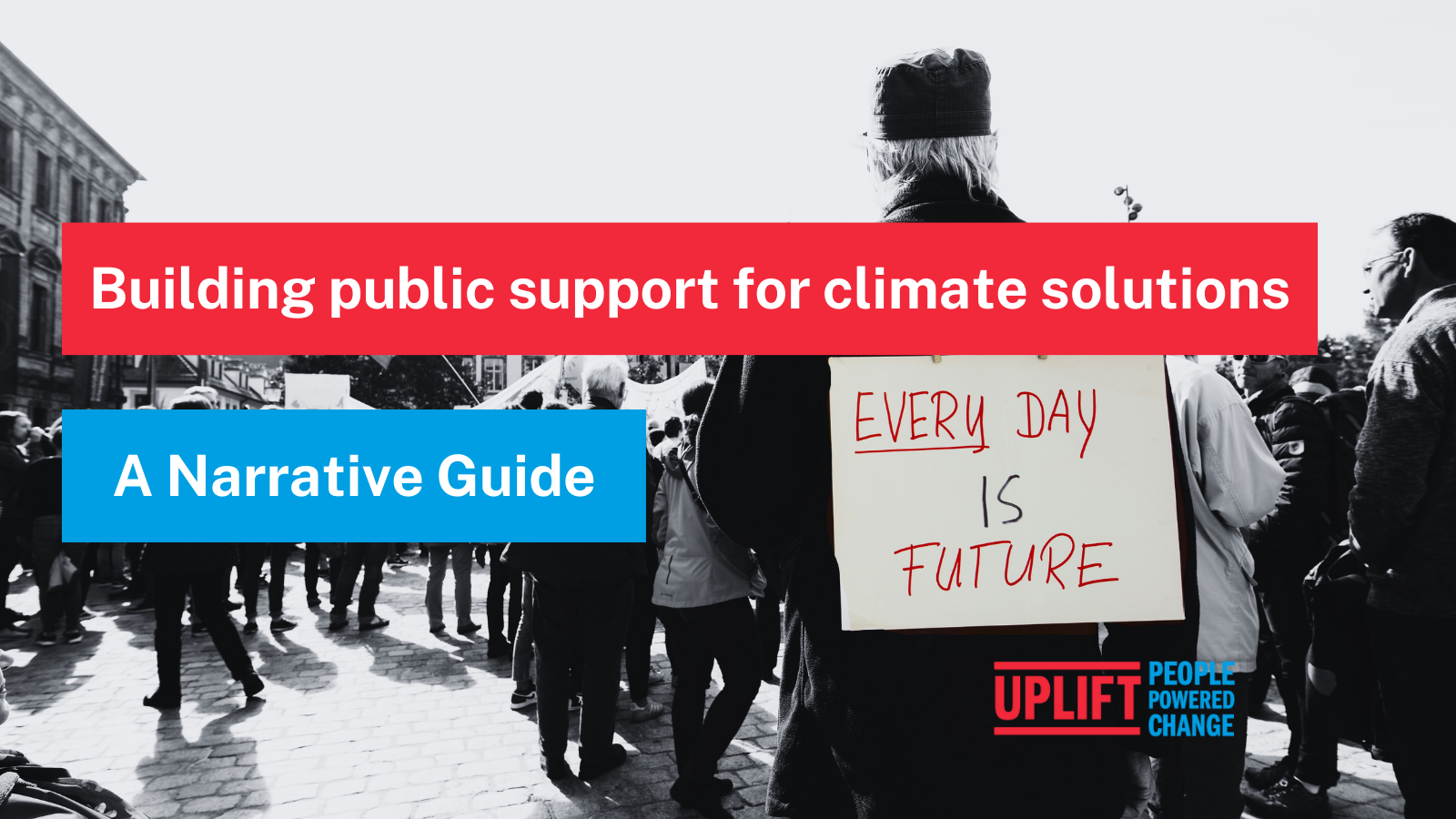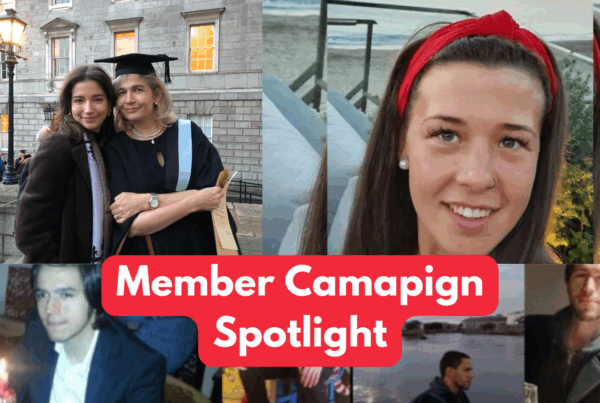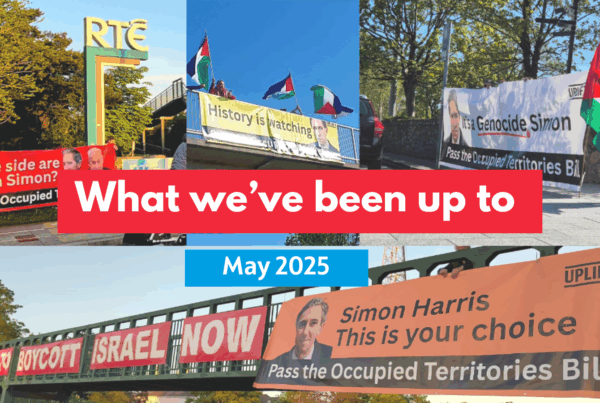
Introduction
Climate change is the biggest threat to our safety and health we have ever encountered. So how do we get the conversation about climate change so loud and clear, that future governments know they have no choice but to stop those responsible for poisoning our air, water, soil, nature and threatening our very existence.
This is a resource for all change makers and has been created based on a deep listening project undertaken in Co Kerry in 2023 – here. We set out to uncover how regular people feel about climate change, how this relates to their day to day life. We also wanted to better understand how people relate to the public discourse on climate, including their news sources. A language analysis was then undertaken by Parable Grassroots Communications. The learnings, insights, analysis from this project, along with the work of strategic communicators ASO Communications, and our campaigning experience at Uplift.
From doom to action: Creating compelling narratives for climate solutions
People are not the problem.
Most people in Ireland care about climate change, trust the science and believe we must reduce toxic emissions. Yet they are quite reasonably fed up. They feel corporate leaders and government decision makers are let off the hook and that there is too much emphasis on individuals. They also feel condescended to, that there is too much emphasis on problems, and that climate commentators are too preachy.
“Your way of life is under threat and the future is gloomy”
Clear, consistent message of our opposition. It generates strong feelings of fear, loss, individualism and protectionism. Progressives on the other hand, do not have an equally consistent compelling message that connects with the people we need to reach. Our research found that ‘persuadables’ are hearing both sides of the argument – right now the opposition’s framing is stronger.
Say what we’re for in real world change.
The things people say they need to have a decent life, fit perfectly with a transition away from dependency on oil, gas and coal. The way we get there is important, but, if we’re not able to paint the picture of what the future looks like, it’s going to be impossible to persuade people to be involved. “We deserve to breathe clean air, drink clean water and eat healthy food. Like most people we feel we deserve a safe, warm, secure home, we deserve to get to where we need to with ease. We want good jobs close to home that allow us to have dignity in our working lives and our old age and we want to know we will be taken care of when we are sick.”
Lead with solutions, not problems.
Shouting into the void or the energy sapping and the futile “protesting climate change’ is not working. People want tangible, solutions that respond to their material needs and strengthen their sense of belonging. They want to accelerate energy transition and rebalance the grip corporate power and profiteering has on policy, politics and public services. The best way to motivate and mobilise people is by uniting them around a shared vision of the future. When asked ‘what would make your life better?‘ people were unequivocal – public transport and secure homes.
The opposition is baiting us to play by their rules.
Industry messengers and their political supporters trick us into reacting to their arguments. Denial can strengthen belief in the idea being denied. Negation, i.e. farmers are not under threat, is little more than free airtime for the opposition. They have built an effective sense of inevitability about a dark future which essentially gives them licence to continue with business as usual. But the truth is that the future is not yet written.
Get clear who is the ‘villain’ and who the hero can be.
Humans feel the urge to make meaning out of disasters linked to our changing climate. If we don’t explain who caused it, there is a tendency to fall back on blaming natural causes or pointing the finger at each other or adopt wild conspiracy theories. To help people better connect with our messages and to build support for action, clearly name the people and institutions standing in the way of a good life and limiting global heating – and link them together. Then it is possible to build a plan and engage people to do something about it.
Stop telling people they don’t care.
Most people care about climate change but don’t relate to the wider conversations they are hearing. One of the greatest achievements of those responsible for global heating is that much of the discussion is abstract, avoids identifying who is responsible and overly focuses on individual actions.
Metaphors are powerful.
Metaphors paint vivid mental images and evoke feelings and surface underlying values in language and narrative framing. We found that ‘body’ metaphors are effective in helping people to connect with climate change, i.e. talking about the air we breathe, feeling warm, and what we need to be healthy. People with mixed feelings about climate change have a stronger connection to their local environment i.e. they are concerned about fires, roads, trees, dumping etc. The ‘journey’ metaphor also works i.e. concern with future generations and the ageing process. People who care least relate to seasons and weather changing.
Tell stories about collective action.
People know that their individual consumption choices are unlikely to have the scaled impact needed. Without feeling part of a wider collective they doubt their individual efforts will influence decision makers. By creating and telling stories that ‘show not tell’, we create the conditions for change from the starting point of where we live, work, connect.
The bigger ‘we’.
Our calls to action need to be grounded in stories that validate our shared values, experiences and show the power of solidarity and belonging. Research including our own underlines how disconnected and frustrated many people feel from the discussion on climate. Stories that foster solidarity across ethnic and social class are particularly important.
Get into local media.
Local media is popular as a news source with people who are ‘persuadable’ on climate change. Local media is also an important way politicians take a steer on what their voters care about. Social media is the most popular source of information for those who are not interested and disengaged, especially TicToc for younger people.
Get out of the bubble.
People are more open to listening, when it comes from someone they know, using language that is relatable. Persuasive narratives only work if they spread, i.e. the people most motivated must be convinced enough to share them. Don’t water down the ask/message, make assumptions, set the bar low or communicate into a void. Do design, test and frame narratives that resonate and are grounded in lived experience. Do focus on who is responsible for x and make them the clear target. Then create a credible strategy that supports people to step up i.e. agency.
Narrative Example
Adapt where needed. Core structure – lead with shared values, name the problem and who is responsible, including their motivation. End with the action/way forward.
All of us, no matter who we are or where we come from, deserve a safe warm home to call our own and the ability to get to where we need to with ease. We deserve clean air in our lungs and clean water to drink, as well as green spaces for us all to enjoy.
But a handful of profiteers and politicians block us from having what we need. Greedy landlords refuse to lower rents or insulate our homes, big businesses pollute our rivers and lakes, and politicians choose not to fund better buses or homes we can afford.
We will have a thriving [county/town/area] for everyone if we hold those who make the decisions responsible, for delivering what we need. That means fighting for regular buses so we can move around with ease, well insulated, affordable homes that are easy and cheap to heat, green spaces, clean water to drink and clean air in our lungs.
If we do X then we can make Y do Z.
Do say/Don’t say Guide
This ‘Do say/Don’t Say guide is a useful way to reframe or shape communications. It is based on the language analysis carried out in 2023 by Parable Communications
Summary of some key replace/embrace messages
| Replace | Embrace | Why |
|
Save the planet Our leaders are not listening Act now for climate change The planet is on fire |
We have it in our power to repair the damage to nature, save lives, be healthy – if political and corporate leaders change their ways. Politicians are looking for our votes, so this is our chance to force them to remove the barriers for all of us, no matter our income, to have what we need, to live safe, healthy lives Transport that gets us to where we need to be, run on clean energy and is affordable Warm homes, powered by clean affordable energy 100% grants and loans at point of purchase so that everyone can have healthy homes, schools, community buildings, farms, transport, powered by clean energy |
Does not lay out a path for overcoming the barriers to realising the future we want. Presents climate change in abstract terms, reinforcing the idea that it is the ‘villain’ not the result of the activities of corporate and political power. Personifying “climate change” – makes it the actor in our messages, which precludes organising. You can’t protest “climate change. But you can go after the individual decision makers – corporations, agencies, politicians. Evokes values of protectionism Makes people fearful, an inhibiting emotion |
| It’s hopeless. |
The future is yet to be decided. Our opponents want us to believe that there’s no hope, no point in trying. Why? Because when we give up, they can keep polluting our communities, air/water… |
Yes, climate change has already altered our world. But we need to hold up that we live with huge uncertainty, which also means radical possibility. Lots of the changes that have ever happened started small, in the shadows. Everyone has something to contribute. The nature of change is unpredictable. |
|
Air pollution Water pollution Food security |
Safe air to breath, Safe water to drink Healthy food to eat |
Paint the picture of what we want |
| Energy transition |
We deserve to be able to get to where we need to, using transport thats clean and affordable The energy that powers our homes needs to be safe, clean and affordable |
Focus on what switching to cleaner energy will give people. |
| Communities are impacted/exposed/at risk of… |
Corporate bosses & politicians who are responsible for dumping, polluting our rivers etc …the politicians who decided to allow… |
Avoid using passive language. Name the villain Communities don’t just happen to be exposed – something and someone is responsible |
| Nature, biodiversity is threatened, destroyed |
Fish in the sea, bees, butterflies, birdsong, trees, insects Less flooding, hedge cutting, burning the countryside, cutting trees… |
Paint the picture. Avoid using ‘policy speak’ |
| We all have to give up something or this will cost money. |
We all want to be safe and secure. Yet a few dirty fossil fuel corporations exploit social divisions so they can poison our lungs for profit. United we can make sure our kids grow up healthy by switching to clean energy… |
Negative demands or speak, nearly without exception, of what we seek to eliminate, not what we desire to create fuels fear and cynicism |
|
Our world is doomed. It’s too late |
We’ve won before. Remember when we… Blocked fracking from being allowed in Ireland, Stopped corporations being given the right to sue the Irish government for interfering with their profit margins |
If we don’t believe we can win, then we should stay quiet! Think big ‘We’. The more people feel they were part of making a difference, the more motivating it is, the less they feel on the outside. We tend to overestimate the size and power of our opponents (thanks to their marketing efforts and the amplification of their image everywhere we look). Important to build confidence |


